#from its inspirations [completely different dress; different spiritual castes and practices; a religion that is almost the complete inverse
Explore tagged Tumblr posts
Text
(ran this reblog through a discussion with some people who have more experience in storytelling/gamedev than i do and some who are central asian indigenous [which i'm not] to get their point of view on the Kin so it's probably going to be long because I'm condensing multiple discussion pieces in one, it's gonna be one of them Long Posts)
while the Kin is obviously heavily inspired by the Buryat, including in its language which does contain a lot of Buryat words, but also a lot of not-Buryat words (Yargachin, pointedly incredibly important in the game, is Mongolian directly. as stated above, Yas & Merdrel are also Mongolian), I do not know if I agree that finding the other inspirations is "forgetting that and trying to match them to other cultures". The Kin is not "its own somewhat distinct culture", it is its own, imagined, invented, imaginary culture, which takes inspiration from (/plainly steals) from existing ones. It is an imaginary people with heavy foundational roots, in the same way the town is imaginary with heavy foundational roots, and the disease itself is imaginary with heavy foundational roots. It is obvious the game takes inspiration from the Buryats (and from others), but it also, in the name of storytelling, creates a religion which is almost an inverse of Buryat Tengrism (Tengrism, with Kyuk-Tengri, father-sky-god as head of the pantheon, being, from what i'm understanding, pantheistic [the Main God is in everything, and everything is a manifestation of him], polytheistic [while Tengri is the main one, there is a heap of other gods, goddesses and spirits under/around him, with great importance placed on those spirits [44/55 associated with different things]], and of course with a main head of a father-sky-god; whereas the Kin's religion, with Boddho, a mother-earth-goddess* [whose name seems to relate more to Mongolian], is pantheistic [mother Boddho is in everything and everything is a manifestation of her], monotheistic [she is the only one, the all-mother, all-creatoress] OR duotheistic [her + Bos Turokh are the only deities], and lacking in spirits entirely, which are so important to Tengrism), has an important spiritual caste of women (the Herb Brides) who have no resonance within Altaic/Mongolic/Turkic cultures because no culture has Naked, Dancing Young Pretty Women Whose Sole Job is Dancing For Harvest (some types of goddess-priestesses / witches / oracles have always existed, but the Herb Brides are a distinct, obvious invention, which deserves scruteny. you could argue that they correlates with shamans, but in the text it appears evident that is more the place of Burakh [father, then son], and the Herb Brides directly go against a widespread shamanic practice which is the wearing of many layers made of animal skins, bones, antlers, horns in order to disguise oneself, to wander between worlds, to trick the tricksters, etc), and also like. Worms. "crude", "unfinished". half-man half-dirt.
*the cult of an earth-mother/mother-earth exists in Buryat Tengrism with Umai, because earth-goddesses exist/have existed in most pantheons, especially before the advent of pastoralism; however, she is daughter of Tengri, whereas Boddho is all-mother. Mongolian Tengrism has her be named Etugen, and while she is said to have all control over the natural forces and all living forces be subordinate to her, Kyuk-Tengri is still "above" her, she is the "second highest" after him. the existence of a earth-goddess within two religions does not make them more similar than any others (the Greeks had an earth-goddess, Demeter, with theories that she was there before the advent of the hellenic pantheon as an all-mother... etc etc so on). there is also sources stating that at some point, Tengrist or proto-Tengrist peoples might have worshiped him/a sky-father exclusively or so majoritaly that the other deities were aside, but it could also come from biased or outside sources.
we are also unsure about your claim that the Kin represents the Buryats in "interesting and careful" ways. We do not know of your position wrt indigenity (and it's none of my business specifically, might be the business of those in the group who are indigenous but i'll let them decide if they want to contact you directly) and if you were doing research on the Buryats out of a reconnecting journey or intellectual curiosity/desire and personally feel that the Buryats are respectfully represented in P2 as one, but I have read many other Central Asian Indigenous people in this fandom write, since the release of P2 (and possibly before that about P1, as well as in the discussion we were Just Having about this ^) about how the Kin does not represent them faithfully, or even sometimes just kindly, and the treatment of it and its members being insulting in multiple ways (including the fact that their beliefs and language are a hodgepodge of languages and beliefs that feels to "steal" from multiple sources [=appropriative instead of appreciative] which itself is another discussion, do not represent any real-life religion while obviously being inspired by some, and on other levels just the fact that the Kin's clothes do not resemble the vibrant, intricate, and historically-significant clothing of the Buryats, or any of the peoples they are inspired by. That and the fact that they literally have non-human/in text sub-human members [the Worms]). Most of the discussions around the Kin that i've seen, from Central Asian Indigenous people, recognizes and celebrates the inspirations (plural) while still interrogating how callous, cruel, sexualizing and misogynistic the narrative and metanarrative treatment of the Kin is, a far cry from a "careful and interesting way" of representing the Buryats (or any of the other inspirations).
last thing: I am personally curious as to where/how you've found the "half Chinese" data piece, because I have not been able to find anything of the sort online (doesn't help that my grasp on Russian is nonexistent). I have seen it going around, without a source, and I also have seen (in the tags of this) the data of "1/16 Manchu or Han", which is a far cry from "half-" anything, and not related to Shenekhen Buryats. [deleted the rest to add:]
Dybowski, from his own mouth, is not half-chinese, and the tagger who mentioned it being 1/16 was right: on page 57 of [this interview], he mentions his grandfather's father (so great-grandfather) having married a Chinese woman (when he was 60 and her 20, but that's a whoooole other story), making him 1/16 chinese (possibly Han or Manchu as the tagger mentioned). I do not doubt this informs his view of the world and how he is treated, even if he mentions being "the only one in [his] family who really looks Russian", but it is a far-cry from "half-" anything. that does not change the general discussion i've read for years at this point around the Kin, which is that the inspirations are obvious and should be celebrated, but it is obviously imaginary/invented, and in the hazy lines of imagination lies a treatment of the Kin which is cruel, crude, sexist (more specifically misogynistic), often racist and feels more like appropriation for a morally gray ethnicity that pays lip-service to its inspiration but mistreats it nonetheless rather than full, hearty representation.
great discussion! 👍🫂 i'm genuinely glad we can exchange on this. but what is contained in your reblog is, from what i've seen and read, pretty far from the consensus on the Kin. we all can recognize (and we should appreciate and take good care in handling) the real-life inspirations while still seeing that, in the blurry lines of storytelling and "invention" for the sake of (technically) a ~fantasy~ ethnicity, lies like. a racist mistreatment with appropriative qualities. which i've seen people talk about for years at this point.
the pathologic Kin is largely fictionalized with a created language that takes from multiple sources to be its own, a cosmogony & spirituality that does not correlate to the faiths (mostly Tengrist & Buddhist) practiced by the peoples it takes inspirations from, has customs, mores and roles invented for the purposes of the game, and even just a style of dress that does not resemble any of these peoples', but it is fascinating looking into specifically to me the sigils and see where they come from... watch this:
P2 Layers glyphs take from the mongolian script:

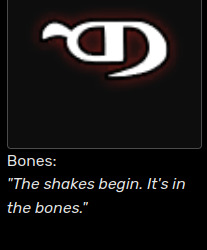

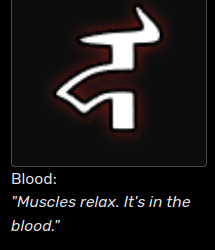

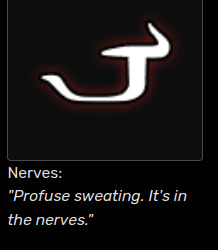

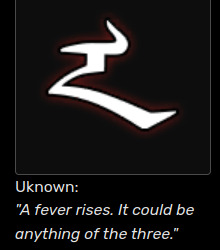
while the in-game words for Blood, Bones and Nerves are mongolian directly, it is interesting to note that their glyphs do not have a phonetic affiliation to the words (ex. the "Yas" layer of Bones having for glyph the equivalent of the letter F, the "Medrel" layer of Nerves having a glyph the equivalent of the letter È,...)
the leatherworks on the Kayura models', with their uses of angles and extending lines, remind me of the Phags Pa Script (used for Tibetan, Mongolian, Chineses, Uyghur language, and others)


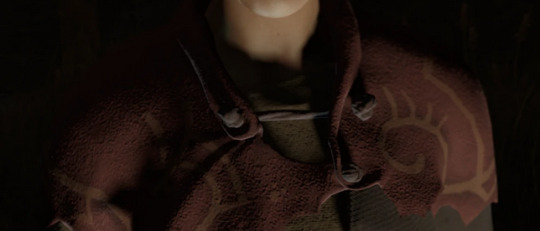
some of the sigils also look either in part or fully inspired by Phags Pa script letters...




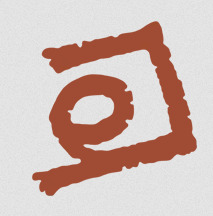

some look closer to the mongolian or vagindra (buryat) script

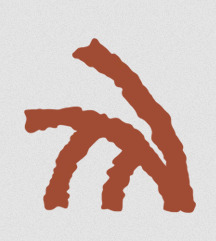



looking at the Herb Brides & their concept art, we can see bodypainting that looks like vertical buryat or mongolian script (oh hi (crossed out: Mark) Phags Pa script):
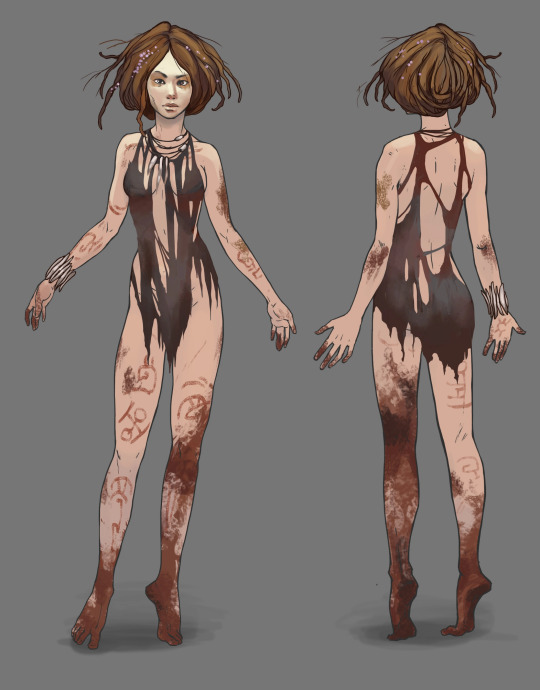
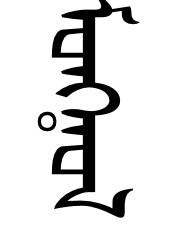
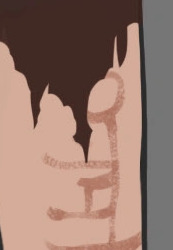
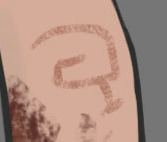

shaped and reshaped...
#i brought it up in the gc because it was my impression and i wanted to check in with people who have been here longer than me + are also#more impacted than me but i've always seen the discussion around the Kin to be like ''yeah [x] is obvi inspired by [ethnicity]; [y] is#obviously inspired by [ethnicity]; but [z] is hogwash hodgepodge and [ethnicity] doesn't do that and [a] is hogwash hodgepodge [...]''#like i will not lie to you. i have not seen an indigenous person in this fandom truly believe that the Kin is in any way respectful/careful#to any culture it is inspired by. but then again 1) love to hear dissident opinions; that's what Discussion is for and 2) maybe i just#haven't looked far enough! that's perfectly possible!#i've seen (& continue seeing) people recognize and appreciate the bits and pieces of the Kin that Do have obvious correlations [the Buryat#belief of the Earth needn't be cut+needing ask for permission to dig; the Trials of p1 which i've seen native american people relate to;...#but like. ''yeah it's careful/respectful'' has never been a sentence i ever come across about the Kin. won't lie.#like for every post i read about how the Kin is a respectful homage to [ethnicity] i read 2 to 4 abt how it's a disrespectful sexualizing#hodgepodge of (sometimes unrelated) sets of beliefs and mores that the game both wants you to interact with as a narratively-understood#racism problem in-game & Also is racist itself and lacks so many distinctive qualities of [ethnicity] to the point it feels just like ''one#of them fantasy ethnicities white authors make for their YA novels that are SWANA-inspired but they won't fucking bother doing their#research on which one they want to appropriate'' - GC message [permission to share]#like i am but the messenger on this [because again. not CA indigenous. but i know people who are and i read things by people who are#and i've run this reblog through people who are etc] but most of the discussion around the Kin does Naht go in the sense of#''it's a careful and interesting [way of handling the Buryats/Mongols/...]''. most people i've read talk about it#are somewhat pissed lol. which again. it's perfectly normallll to have dissident opinions. in the Perspective game.#tldr; imaginary and imagined people with obvious and very clear inspirations but in the blurry edges in the ''imagination'' & ''invention''#lies some disturbing racist/misogynistic/appropriative shit; which lead writer D.; even if half-chinese or 1/16 Han or Manchu*;#[ETA: 1/16 was right] still can fuck it up big big time.#also considering his Allegations towards women and girls everyone can side-eye his treatment of the Herb Brides; regardless of if we think#that's a ''respectful'' invention based on RL ethnicities#neigh (blabbers)#anyways. genuinely good discussions to have and partake in; even if it's obviously different visions on the matter.#i'm also really attached to like. creating fantasy ethnicities for storytelling but like all storytellers you haaaaave you have to do your#research to handle the ethnicities you're ''basing yourself on'' properly.#the whole argument here [which other people have more eloquantly/personally described than I] is that the Kin is both different enough#from its inspirations [completely different dress; different spiritual castes and practices; a religion that is almost the complete inverse#of buryat tengrism; the herb brides; the worms;...] but also Similar Enough that we have to consider like. both parts of the equation
305 notes
·
View notes
Text
Basic Witchcraft Questions
Frequently asked questions answered with the help of multiple reliable sources.
-What is Witchcraft?
The “official” definition of it is the practice of and belief in magical skills and abilities exercised by solitary practitioners and groups known as covens. Witchcraft involves the use of intent (and often physical objects) to manipulate environmental energy in order to effect change in favor of the practitioners.
Therefore, it means lots of things in different environments and it is frequently divided according to the user’ s intention and tools of achieving the results desired.
- Is it the same as Wicca?
Wicca is a belief system and way of life based upon the reconstruction of pre-Christian traditions originating in Ireland, Scotland, and Wales. Wicca is a tradition of Witchcraft. There are a number of people who consider themselves Witches, but who are not necessarily Wiccan.
- What is Paganism?
Paganism is an umbrella term first used in the fourth century by early Christianity for populations of the Roman Empire who practiced polytheism, either because they were increasingly rural and provincial relative to the Christian population or because they were not “soldiers of the Christ”. While most pagan religions express a world view that is pantheistic, polytheistic or animistic, there are some monotheistic pagans. While one group may have a certain practice, not everyone will follow the same criteria.
- Is Magick real?
As a beginner that has not practiced enough to guarantee the right and truthful answer myself (even though I have seen some good results for my level), reasons for the belief or disbelief in it can be easily stated.
Most of us do not live in a culture that supports it. We live in a place that forces action in the world, where the path to independence, self-reliance and happiness tends to rely on rolling up your sleeves and getting stuff done the common practical way in the real world.
So when someone says they have been affected by it or that they think of joining the occult, it is highly likely that he will get negative opinions by his surrounding people.
I personally have really close relatives being victims of it in a negative or positive way and some others practice it cause they have been raised in villages away from big cities and the capital so it was something widely used in their daily lives.
- What do people consider as White and Black Magick?
White Magick is defined as the Witchcraft used for matters like healing and protection , rather from the “selfish” forced gain of the practitioner.
Black magic on the other hand, is what most hesitate to step in when they take into account their beliefs or personal morals since it is widely believed to take energy away to create chaos, destruction, disruption with a nature of forcing things against any wills of the people that participate without their knowledge. (Binding spells, Curses). These
However, nowadays it is a term widely said by people who define magic or ritualistic practices that they disapprove of as Black Magick.
-What types of Magick are there?
The ones you will mostly see around are: Binding Magick: To bind is to keep someone from doing something, almost like putting a wall between them and the chosen thing or the exactly opposite, to make a chosen thing or person stay attached Blood Magick: Blood magic is not magic that involves killing people or animals in ritual sacrifice. It is the use of a few drops of blood during a spell or ritual—usually your own blood, but if you are casting for someone else you could use theirs. Those few drops can add power to a magical working in any number of ways. Candle Magick: Candle magick is often used in spells and rituals and can be influenced by the color, scent and number of candles. Chaos Magick: It is about using whatever ideas and practices are helpful to you at the moment, even if they contradict ideas and practices used previously and a personal system is never developed. What applied yesterday may be completely irrelevant today. All that matters today is what is used today. Experience can certainly help a chaos magician in figuring out what would most likely be useful, but they are never confined by the concept of tradition or even of coherency. Crystal/Stone Magick: There are a multitude of crystals, stones and metals that can be used for many purposes through either simply invoking the energies of the crystals or crystal elixirs. Dream Magick: Dream magick is usually incredibly useful for tapping into the astral and one’s own psyche. Through dream magick, you can connect to the hidden secrets of your mind and to realms you can’t access through the physical. Elemental Magick: Usually in the beginning of a ritual, the elements are invoked and called into the circle for their blessings. However, outside the circle elemental magick can be used by invoking the essential energy of the elements for their specific magicks. Gray Magick: Gray magic (also spelled magick) is magic that is not performed for specifically beneficial reasons, but is also not focused towards completely hostile practices It is seen as falling in a continuum between white and black magic and could be also called neutral magic Herbal Magick: Usually employed through incense, tinctures or a long list of other herbal products in order to invoke their essences. If you?re ever having trouble finding something to work magick with for a very specific purpose, look through your favourite herbal magick book and you?ll almost definitely find something to help you. Hoodoo Magick: Hoodoo is a set of magickal practices originating in Africa which, through the process of syncretism, has absorbed some beliefs and practices from other cultures such as Native American spirituality and European Ceremonial Magick. Hoodoo tradition emphasizes personal magical power invoked by the use of certain tools, spells, formulas, methods, and techniques. It ascribes magical properties to herbs, roots, minerals, animal parts, and personal possessions. Some spells even make use of body materials (blood, tears, nail clippings, hair…etc) Knot Magick: Knot magick is a very ancient practice that usually is based on the number of knots tied on a cord, usually with purposes for each knot. Healing Magick: Healing magic can be accomplished through a variety of methods. It can be done through straight energy transfer (reiki and other methods), poppet magick, herbal magick, crystal magick and almost every other magick type for results. Poppet Magick: Poppet magick was popularized in the practice of voodoo but has been used in many different magickal systems in history. Usually ?poppets? are made of cloth or was and are activated with a possession (be it an object or a hair clipping etc) to attach the energy of a person to the poppet. Sigil Magick: Sigils are the symbols that are attributed to most spirits that are found in grimoires but could also represend intents. At the first case, you can almost imagine the sigil to be the spirit’s phone number. Weather Magick: For most people, weather magick is one of the most difficult types of magick to work. As the title speaks of, weather magick obviously has to do with controlling the elements in order to change the weather for certain purposes. This kind of magick is difficult for a reason: it is not to be taken lightly as weather systems in one area usually can affect the whole world in a domino effect. Voodoo Magick: Hoodoo spells are also often confused with Voodoo magick but it’s another form of African witchcraft.
- What are the most common and basic tools needed to practice witchcraft?
It totally depends on the type of magick you will use. You do not need to have all of those tools to receive successful results and remember that the most basic tool is the right training and usage of your mind and concentration. Let’s see the most common ones: Altar - The altar is often considered a personal place where practitioners put their ritual items. Some practitioners may keep various religious items upon the altar, or they may use the altar and the items during their religious workings. Cauldron - The cauldron is probably the tool most associated with witchcraft and is steeped in magickal tradition and mystery. The cauldron is the container in which transmutation, germination, and transformations may occur.In ritual the cauldron is used as a container for making brews and potions, or to contain a small fire for use with spells. It can also be used for scrying (divination) by filling it with water and gazing into its depths. Incense - Incense is one of the more common magical tools. Many practitioners use incense for nearly every magical act, from simple meditations to elaborate rituals. It’s not that its a very powerful or versatile tool, but it is a fairly useful one. Candles - Candles are frequently used for magical meditative purposes, in healing rituals, to help increase a spell’s power, or to influence a particular power. Candles are believed to be able to help one concentrate and absorb personal energy and release it when burned. In preparing to cast a spell, the person may dress or anoint the candle with an anointing oil while concentrating upon the purpose of the spell. Stones and Gems - each one is unique and exudes a specific energy, a crystal or gemstone may be used for healing, magic, spell casting, to inspire, uplift, balance, calm and energise Dressing oils - Essential oils can be used for that, usually a mixture of them and other ingridients. Essential oils - Used for their powers such as to anoint altars, incense burners, good fortune when added to incense, protection against evil & ill luck.
- What are spirits and how are they used for rituals?
We are souls temporarily in a physical bodies on Earth. However, our natural home is in the Spirit World, commonly also called the Other Side. Whether we realize it or not, spirits (or souls) surround us, whether in human bodies or “ without bodies. Because our natural home is the Spirit World, being without a physical body is our natural state. A spirit is simply nothing more and nothing less than another person and they are said to have a huge variety on size and powers, just like the animals on our planet. Every angel, demon, genius spirit and other supernatural being has preferences, styles of work and methods that make this contact more accessible. This is why there are different rituals for every different class of spirit. Some require elaborate rituals, while others only need to sense a sincere need. Some thrive on gratitude, while others only require that you command them clearly.
- What are spirit relationships and why are we recommended to establish one?
Some people when performing sorcery use only their self creation energy and it can only have so much power. Meaning it can only have up to and including how much power you personally have. If you are working with an actual spirit, you are working with not only your own power but theirs as well.
It is also quite beneficial cause spirits have many more power advantages than us humans who are locked inside our bodies that give us boundaries. So in those who use them in their work, spirits do most of the work and the practitioner is there to direct them. However, most people do not have the skills, or more likely, the patience to develop significant spiritual relationships. It takes time, you have to be ready and not let most of what you have been taught from invalid sources about them be a priority in your mind.
- What is evoking / invoking?
Invoking is where you invite an entity and it steps into your body. You become them, and they become you, and you absorb the energies they leave you.
Evoking on the other hand, is much different. This is more commonly done, though it is seldom said. Evoking is the act of inviting a deity or element to come to your circle, Not be within you.
-What are the Spirit Guides and how could they help me?
Spirit Guides are what many consider to be spirits that stay with you throughout your entire life or pop in every now and again to help you with specific areas of your life or goals you are trying to achieve. These guides are at varying levels of consciousness themselves. What can be said about them is that theu do not mess with your free will, or try to get you to make decisions. The guides you want to work with will only be there to lovingly support, encourage and teach you in your current incarnation. They want the best for you, and will help you achieve it. However, hey will not prevent you from making bad decisions. Some things are meant as lessons, and if you purposely put yourself in harms way, they don’t just jump in and rescue you, although what we call angels have been known to do that, most guides will not.
They help you by Sending signs, such as repeated scenes or even numbers, by sending specific people in your life or even causing you to see dreams with a certain meaning behind them.
-What is Karma on Magick and the Threefold Law?
Taking into mind a sum of all that an individual has done, is currently doing and will do, Karma is the universe’s reaction to it. Something like “What goes around, comes all the way back around.” Negative Karma offers punishment and Positive gives rewards. It is connected to magick via the intentions of the practitioner during the ritual. For example, if one casts a hex, according to the popular idea of karma working as a cosmic judge of all of our actions, it will hit the person back. The Rule of Three (also Three-fold Law or Law of Return) is a religious tenet held by some Wiccans/Pagans. It states that whatever energy a person puts out into the world, be it positive or negative, will be returned to that person three times. The Rule of Three is sometimes described as karma by Wiccans; however, this is not strictly accurate. Both concepts describe the process of cause and effect and often encourage the individual to act in an upright way Some people strictly believe in those and because of so, refrain from stepping into “selfish” magick and some others state that they have witnessed nothing bad caused to the ones that perform “darker” magick.
- What do I need to know before practicing Black Magick as a beginner?
Try not to jump straight into advanced areas until you build the basic skills and experience . It is mainly suggested you spend a significant amount of studying about it so your knowledge can build itself, and by the time you reach advanced practices you have little fear as you know the knowledge behind the words, and you have the skills to handle yourself in most situations.
What is considered dark magick could possibly not only bring some sort of disaster but also draw negative spirits that are hard to get rid of if you don’t know what you are doing in the first place.
More to come soon.
#witchcraft#wicca#witch#wiccan#pagan#paganism#blackmagick#blackmagic#black magick#black magic#whitemagic#whitemagick#white magick#white magic#sorcery#magick#magic#basics#ritual#spell
21 notes
·
View notes
Text
Elemental Road Opener: Wiccan Prayer + Ritual

Road opener rituals are great for finding the way out of a stagnant situation and moving forward in life. If you are feeling stuck or having a hard time with a specific problem 🔗, this simple spell might help you find the right course of action.
This is a road opening ritual inspired by Mexican bruja Yeel Maló, who works with the ray of Archangel Gabriel, the celestial messenger. The spell recipe on this page has been modified to invoke the Universal Elements instead.
You can dedicate this prayer to a different patron saint or deity. If you need inspiration for your devotional practice, visit today’s ruling deities or learn about the God and Goddess of Wicca.

How this Spell Works
Also known as “Abrecaminos“, a road opener prayer is similar to an uncrossing or block buster in Hoodoo or American rootwork. It directs the intention toward untangling, removing obstacles. This easy candle burning ritual will clear your thoughts toward finding the solution to any problem.
While you can find “road opener” oils and candles in many stores, this type of ritual can be done at home with only kitchen ingredients.
We will work with each of the 4 Elementals for a Wiccan ritual. A bowl of water will symbolise the Water Element; a crystal or gemstone the Earth; an incense stick for the Air; and a candle for Fire.
What incense should I use? Pick an aroma that matches your intention. You can browse the Green Witch course to learn about the properties of different herbs. Cinnamon is a great option because of its warm, comforting smell that sanctifies the ritual area.
If you don’t have a crystal or gemstone for this spell, use a bowl filled with kitchen salt instead.
Road Opener Wiccan Candle Ritual
Recipe by Francisco Huanaco
An easy road opener spell with a candle and a Wiccan prayer. Invoke the 4 elementals to clear and unlock solutions to your problems.
WHAT YOU’LL NEED
Bowl of water (regular drinking water)
1 incense stick
1 crystal or gemstone (pick one according to the day)
1 white candle
HOW TO DO A ROAD OPENER SPELL
Arrange your items on the altar. Each element will face one of the four directions: Water faces West. Air faces East. Earth faces North. Fire faces South.
Light the incense. The Air element is entering your ritual.
Rub your hands for a few seconds until you can feel a warmth energy, visualise a ball of energy and hold your crystal, you are invoking the Earth element.
Light the candle to call upon the presence of the Fire element.
Gently dip a finger in the water to feel the company of the Water element. Water represents a state of flow, a mirror that can open the door to a new reality. This transforming energy will clear all blockages.
Chant the following road opener prayer:

Visualize an empty road. Meditate for a few minutes as you see yourself moving forward.
Let the candle burn completely and always practice candle safety. If you need to leave the room, put out the candle and continue burning it later.
Once the candle is burned, toss all remains away while saying Thank you. Keep the crystal close to you. If you need to invoke the power of this spell, rub your hands and hold it in your hands again.

Frequently Asked Questions
What’s the best Moon phase for a road opener spell?
The New Moon or Waxing Crescent Moon phases are perfect for casting a road opener spell because they symbolise new beginnings. The start of a lunar cycle is ideal for spiritual works of renewal and fresh starts.
What day to do a road opener spell?
Any day of the week will work, but you can choose a specific day according to your intentions: If you’re working on a road opener for love, it’s best to do it on a Friday. If this is a job finding ritual, Sunday or Monday are your best options. For a great road opener spell for money, cast it on a Thursday instead.
What is “Abre Camino”?
Abre camino translates literally from Spanish as “Road opener”. It’s both the name of a practice in Santeria and Palo religions, and the common name for a plant. Known as Common Boneset in English, Eupatorium villosum is native to the Caribbean and can be found mainly in Puerto Rico and Cuba.
Abre camino rituals don’t necessarily use the abrecamino plant, and sometimes use various other plants and ingredients.
When to do road opener spell?
Cast a road opener spell if you are feeling stuck in your current situation. For example, there are students who are in school and can’t advance or aren’t getting good enough grades. We say their paths are blocked. With a road opener ritual these paths will be cleared once and for all. Their mind will be clear and they will understand what they need to do in order to graduate or improve their grades.
If you are trying to buy or sell a house and feel that you’re stuck or can’t move forward with all the paperwork, this ritual is also very helpful. If you’re going through a court case or immigration procedure and feel that your case is not going anywhere or they’re not giving you any answers, this ritual will help you.
What does a road opener spell do?
Road opener rituals help remove anything that prevents you from moving forward. They offer a safe attempt to eliminate obstacles or barriers. A road opener or unblocking ritual will help you change a circumstance that is adverse. We do with by placing the energy where it needs to be (the solution) and taking it away from where we don’t want it (the problem).
Many of these rituals include prayers to Catholic saints such as the road opener to St Cyprian or St Cajetan (San Cayetano). There are also novenas, long candle burning rituals and offerings for the opening of roads.
How to make this ritual more effective?
Take a cleansing bath before you begin. Use road opener herbs such as cinnamon, basil or lemon. Dress your candle with an essential oil that matches your intention.
Focus on the necessary opening for your situation. Many times we wish to open a door that we don’t really need to open. When you make a petition or wish, you can say: “I am receiving __________ and if this is not what I require, let the Universe show me what will bring me growth.”
Have faith. Everything that is done with great faith is ultimately achieved. Use the mental and spiritual energy that you naturally have. Whenever you are going to do cast a spell, put all your energy into it.
https://spells8.com/elemental-road-opener/
0 notes